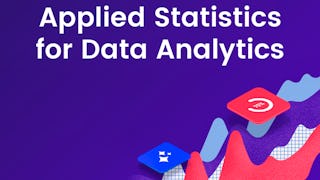Comprendre les statistiques est essentiel pour comprendre la recherche en sciences sociales et comportementales. Dans ce cours, vous apprendrez les bases de la statistique, non seulement comment les calculer, mais aussi comment les évaluer. Ce cours vous préparera également au cours suivant de la spécialisation - le cours Statistiques déductives.



Statistiques de base
Ce cours fait partie de Spécialisation Méthodes et statistiques en sciences sociales


Instructeurs : Matthijs Rooduijn
303 826 déjà inscrits
Inclus avec 
(4,553 avis)
Compétences que vous acquerrez
- Catégorie : Statistiques
- Catégorie : Logiciel statistique
- Catégorie : Analyse de régression
- Catégorie : Statistiques descriptives
- Catégorie : Distribution de probabilité
- Catégorie : Analyse de corrélation
- Catégorie : Détermination de la taille de l'échantillon
- Catégorie : Tests d'hypothèses statistiques
- Catégorie : Inférence statistique
- Catégorie : Échantillonnage (statistiques)
- Catégorie : Probabilité
Détails à connaître

Ajouter à votre profil LinkedIn
9 devoirs
Découvrez comment les employés des entreprises prestigieuses maîtrisent des compétences recherchées

Élaborez votre expertise du sujet
- Apprenez de nouveaux concepts auprès d'experts du secteur
- Acquérez une compréhension de base d'un sujet ou d'un outil
- Développez des compétences professionnelles avec des projets pratiques
- Obtenez un certificat professionnel partageable


Obtenez un certificat professionnel
Ajoutez cette qualification à votre profil LinkedIn ou à votre CV
Partagez-le sur les réseaux sociaux et dans votre évaluation de performance

Il y a 9 modules dans ce cours
Dans ce module, nous examinerons les bases de la statistique. Mais avant de commencer, nous allons vous donner une idée générale de l'objet du cours et de son organisation. Vous êtes nouveau sur Coursera ou vous ne savez pas encore si ce cours est fait pour vous ? Dans ce cas, n'oubliez pas de consulter les sections "Introduction au cours" et "Ce que vous pouvez attendre de ce cours" ci-dessous, afin d'obtenir les informations essentielles dont vous avez besoin pour prendre votre décision et réussir ce cours ! Si vous avez des questions sur le format du cours, les délais ou l'évaluation, vous trouverez probablement les réponses ici. Vous êtes un habitué de Coursera et vous êtes prêt à commencer ? Dans ce cas, vous pouvez passer directement au premier sujet du cours : explorer les données". Vous pourrez toujours consulter les informations générales plus tard. Vétérans et débutants : N'oubliez pas de vous présenter dans le forum "meet and greet" !
Inclus
1 vidéo11 lectures1 devoir
Dans ce premier module, nous introduirons les concepts de base des statistiques descriptives. Nous parlerons de cas et de variables, et nous expliquerons comment vous pouvez les ordonner dans ce que l'on appelle une matrice de données. Nous discuterons des différents niveaux de mesure et nous vous montrerons comment vous pouvez présenter vos données au moyen de tableaux et de graphiques. Nous vous présenterons également les mesures de tendance centrale (comme le mode, la médiane et la moyenne) et de dispersion (comme l'étendue, l'écart interquartile, la variance et l'écart type). Nous vous expliquerons non seulement comment les interpréter, mais aussi comment les calculer. Enfin, nous vous en dirons plus sur les scores z. Dans ce module, nous n'aborderons que les situations dans lesquelles nous analysons une seule variable. C'est ce que nous appelons l'analyse univariée. Dans le module suivant, nous présenterons également des études dans lesquelles plusieurs variables sont impliquées.
Inclus
8 vidéos5 lectures1 devoir3 éléments d'application
Dans ce deuxième module, nous nous intéresserons aux analyses bivariées, c'est-à-dire aux études portant sur deux variables. Nous commencerons par introduire le concept de corrélation. Nous étudierons les tableaux de contingence (pour les variables catégorielles) et les diagrammes de dispersion (pour les variables quantitatives). Nous apprendrons également à comprendre et à calculer l'une des mesures de corrélation les plus fréquemment utilisées : le r de Pearson : Le r de Pearson. Dans la partie suivante du module, nous présenterons la méthode d'analyse de régression par les MCO. Nous expliquerons comment vous (ou l'ordinateur) pouvez trouver la droite de régression et comment vous pouvez décrire cette droite au moyen d'une équation. Nous vous montrerons que vous pouvez évaluer l'adéquation de la droite de régression à vos données à l'aide de ce que l'on appelle le r-carré. Nous conclurons le module en expliquant pourquoi vous devez toujours être très prudent lorsque vous interprétez les résultats d'une analyse de régression.
Inclus
8 vidéos6 lectures1 devoir1 élément d'application
Ce module introduit les concepts de la théorie des probabilités et les règles de calcul des probabilités. Ces notions sont utiles non seulement pour répondre à divers types de questions statistiques appliquées, mais aussi pour comprendre les analyses statistiques qui seront présentées dans les modules suivants. Nous commençons par décrire le hasard et expliquons comment les événements aléatoires nous entourent. Ensuite, nous donnons une définition intuitive de la probabilité à l'aide d'un exemple et nous la relions aux concepts d'événements, d'espace d'échantillonnage et d'essais aléatoires. Un outil graphique permettant de comprendre ces concepts est également introduit ici, le diagramme en arbre. Ensuite, un certain nombre de concepts de la théorie des ensembles sont expliqués et mis en relation avec les calculs de probabilité. Ensuite, un certain nombre de concepts de la théorie des ensembles sont expliqués et mis en relation avec les calculs de probabilité. Ici, la relation est à nouveau faite avec les diagrammes en arbre, ainsi qu'avec les tableaux de contingence. Nous terminons par une leçon où les probabilités conditionnelles, l'indépendance et la règle de Bayes sont expliquées. Dans l'ensemble, il s'agit d'un module assez théorique sur un sujet qui n'est pas toujours facile à appréhender. C'est pourquoi nous avons inclus autant d'exemples intuitifs que possible.
Inclus
11 vidéos5 lectures1 devoir1 élément d'application
Les distributions de probabilités sont au cœur de nombreux calculs statistiques. Elles sont utilisées comme modèles mathématiques pour représenter un phénomène aléatoire et répondre ensuite à des questions statistiques sur ce phénomène. Ce module commence par expliquer les propriétés de base d'une distribution de probabilités, en soulignant comment elle quantifie une variable aléatoire et comment elle diffère des variables aléatoires discrètes et continues. Ensuite, la distribution de probabilité cumulative est introduite et ses propriétés et son utilisation sont également expliquées. Le cours suivant montre comment une variable aléatoire avec sa distribution de probabilité associée peut être caractérisée par des statistiques telles que la moyenne et la variance, tout comme les données d'observation. Le cours présente ensuite la distribution normale, en commençant par expliquer sa forme fonctionnelle et certaines de ses propriétés générales. Ensuite, l'utilisation de base de la distribution normale pour calculer les probabilités est expliquée. Enfin, la distribution binomiale, une distribution de probabilité importante pour les données discrètes, est introduite et expliquée plus en détail. À la fin de ce module, vous aurez parcouru un bon bout de chemin et disposerez d'une base solide pour répondre aux questions statistiques les plus fréquemment rencontrées. Il est important de noter que les connaissances fondamentales sur les distributions de probabilités qui sont présentées ici fourniront également une base solide pour l'apprentissage des statistiques inférentielles dans les modules suivants.
Inclus
8 vidéos5 lectures1 devoir1 élément d'application
Les méthodes permettant de résumer les données d'un échantillon sont appelées statistiques descriptives. Toutefois, dans la plupart des études, ce ne sont pas les échantillons qui nous intéressent, mais les populations sous-jacentes. Si nous utilisons des données obtenues à partir d'un échantillon pour tirer des conclusions sur une population plus large, nous utilisons des méthodes de statistiques inférentielles. Il est donc essentiel que vous sachiez comment constituer des échantillons. Dans ce module, nous prêterons attention aux bonnes méthodes d'échantillonnage ainsi qu'à certaines mauvaises pratiques. Pour tirer des conclusions sur la population dont est issu un échantillon, les chercheurs utilisent une distribution de probabilité très importante dans le monde des statistiques : la distribution d'échantillonnage. Nous examinerons en détail les distributions d'échantillonnage et les comparerons aux distributions de données et aux distributions de population. Nous examinerons la distribution d'échantillonnage de la moyenne de l'échantillon et la distribution d'échantillonnage de la proportion de l'échantillon.
Inclus
7 vidéos5 lectures1 devoir1 élément d'application
On peut distinguer deux types de méthodes d'inférence statistique. Nous pouvons : (1) estimer les paramètres de la population ; et (2) tester des hypothèses sur ces paramètres. Dans ce module, nous aborderons le premier type de statistiques inférentielles : l'estimation au moyen d'un intervalle de confiance. Un intervalle de confiance est une plage de nombres qui contient très probablement la valeur réelle de la population. La probabilité que l'intervalle contienne effectivement la valeur de la population est ce que nous appelons le niveau de confiance. Dans ce module, nous vous montrerons comment construire des intervalles de confiance pour les moyennes et les proportions et comment les interpréter. Nous nous intéresserons également à la manière dont vous pouvez décider de la taille de votre échantillon.
Inclus
7 vidéos4 lectures1 devoir1 élément d'application
Dans ce module, nous parlerons des hypothèses statistiques. Elles constituent les principaux ingrédients de la méthode des tests de signification. Une hypothèse n'est rien d'autre qu'une attente concernant une population. Lorsque nous effectuons un test de signification, nous utilisons (tout comme lorsque nous construisons un intervalle de confiance) des données d'échantillon pour tirer des conclusions sur les paramètres de la population. Le test de signification est donc également une méthode de statistique inférentielle. Nous montrerons que chaque test de signification est basé sur deux hypothèses : l'hypothèse nulle et l'hypothèse alternative. Lorsque vous effectuez un test de signification, vous supposez que l'hypothèse nulle est vraie, à moins que vos données ne fournissent des preuves solides à l'encontre de cette hypothèse. Nous vous montrerons comment effectuer un test de signification sur une moyenne et comment effectuer un test sur une proportion. Nous montrerons également que les tests de signification et les intervalles de confiance sont étroitement liés. Nous conclurons le module en expliquant que vous pouvez prendre de bonnes et de mauvaises décisions lors de la réalisation d'un test. Les mauvaises décisions sont appelées erreurs de type I et de type II.
Inclus
7 vidéos4 lectures1 devoir1 élément d'application
Il s'agit du dernier module, dans lequel vous pouvez appliquer tout ce que vous avez appris jusqu'à présent lors de l'examen final. Veuillez noter que vous ne pouvez passer l'examen final qu'une fois par mois, alors assurez-vous d'être bien préparé à l'examen. Veuillez respecter le code d'honneur et ne pas communiquer ou vous entretenir avec d'autres personnes pendant l'examen. Nous vous souhaitons bonne chance !
Inclus
1 devoir
Instructeurs


Offert par
En savoir plus sur Probabilités et Statistiques


Stanford University


IIMA - IIM Ahmedabad


DeepLearning.AI


University of Colorado Boulder
Pour quelles raisons les étudiants sur Coursera nous choisissent-ils pour leur carrière ?




Avis des étudiants
4 553 avis
- 5 stars
74,13 %
- 4 stars
18,77 %
- 3 stars
4,39 %
- 2 stars
1,14 %
- 1 star
1,55 %
Affichage de 3 sur 4553
Révisé le 15 sept. 2022
I recommend this course to students with no background statistic knowledge, especially art students like me. The pictures with teachers's explaination make it easy and to understand!
Révisé le 27 août 2017
Very Good course. I was pretty much satisfied. R-lab can be improved and better explanations to help us on the test could have been given (after not passing the first time, for example).
Révisé le 5 mars 2016
This course is really awesome. Designed well. Looks like a lot of efforts have been taken by the team to build this course. Kudos to everyone. Keep up the good work and thank you very much.

Ouvrez de nouvelles portes avec Coursera Plus
Accès illimité à 10,000+ cours de niveau international, projets pratiques et programmes de certification prêts à l'emploi - tous inclus dans votre abonnement.
Faites progresser votre carrière avec un diplôme en ligne
Obtenez un diplôme auprès d’universités de renommée mondiale - 100 % en ligne
Rejoignez plus de 3 400 entreprises mondiales qui ont choisi Coursera pour les affaires
Améliorez les compétences de vos employés pour exceller dans l’économie numérique
Foire Aux Questions
L'accès aux cours et aux devoirs dépend de votre type d'inscription. Si vous suivez un cours en mode audit, vous pourrez consulter gratuitement la plupart des supports de cours. Pour accéder aux devoirs notés et obtenir un certificat, vous devrez acheter l'expérience de certificat, pendant ou après votre audit. Si vous ne voyez pas l'option d'audit :
Il se peut que le cours ne propose pas d'option d'audit. Vous pouvez essayer un essai gratuit ou demander une aide financière.
Le cours peut proposer l'option "Cours complet, pas de certificat" à la place. Cette option vous permet de consulter tous les supports de cours, de soumettre les évaluations requises et d'obtenir une note finale. Cela signifie également que vous ne pourrez pas acheter un certificat d'expérience.
Lorsque vous vous inscrivez au cours, vous avez accès à tous les cours de la Specializations, et vous obtenez un certificat lorsque vous terminez le travail. Votre certificat électronique sera ajouté à votre page de réalisations - de là, vous pouvez imprimer votre certificat ou l'ajouter à votre profil LinkedIn. Si vous souhaitez uniquement lire et visualiser le contenu du cours, vous pouvez auditer le cours gratuitement.
Si vous vous êtes abonné, vous bénéficiez d'une période d'essai gratuite de 7 jours pendant laquelle vous pouvez annuler votre abonnement sans pénalité. Après cette période, nous ne remboursons pas, mais vous pouvez résilier votre abonnement à tout moment. Consultez notre politique de remboursement complète.
Plus de questions
Aide financière disponible,

